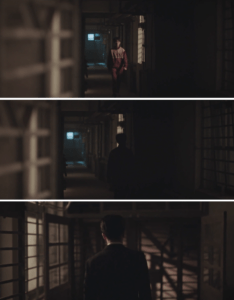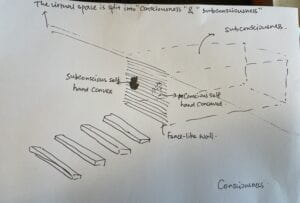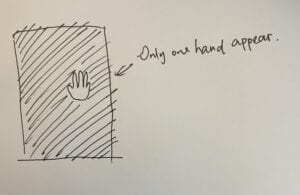WP2WS-W12 INSIDE OUT
Concept Development — Inside Out

In this project, the user can choose to role-play 1) the main character that has trauma experience in childhood, or 2) a supporting character who bullies the main character through physical/online/social violence.
For the main character, he/she will experience a split subjectivity and feel/see through the perspectives of both “selves”:
- the conscious, explicit “self” that dominates his/her daily life and is not affected by the traumatic memory.
- the subconscious, hidden “self” that is suppressed by the conscious self and trapped in the traumatic memory.
After walking through consciousness and unconsciousness, the user will finally be “outside”: by recognizing and accepting the hidden “self” (or the inner “me”), the user can now return to reality with complete subjectivity.
For the supporting character: he/she is the bully which creates a traumatic experience for the main character. He/she will 1) be in dialogue with the main character and type aggressive words; 2) beat the main character; 3) isolate the main character. The violence would be reflected in the corridor through geometry transformation/sound. (Due to the time limit, this part will be the future development of this project. The focus will be the main character’s experience)
This project aims to encourage those who might have an “uncured inner child” to embrace their past and walk toward the future. It also aims to raise awareness of the different types of bullying (cyber violence/physical violence/social violence).
Phase 1: The Self as the Other

I’m walking in the mist and my surrounding is alien to me.
Where am I?
The fog recedes as I advance.
I stop before a wall that shapes like a chain-link fence.
It looks like a prison. Is someone inside?
I raise my hand to touch the wall.
The wall is concaved under my hand.
But is convexed on the other side, also shaped like a hand.
It seems someone inside is touching the wall, too.
Our hands move closer and closer,
Until we touch each other.
In this phase, I fall into my spiritual space of “consciousness”. I’m able to control my movement but cannot see my body. At the entrance to my subconsciousness, I look at the inner “me” and my spiritual space from a third-person perspective. In other words, “I” is the “other”, or the outsider, in relation to the inner “me”, and vice versa.
Phase 2: The Other as Self






The moment our hands overlap,
I’m paralyzed.
I was transported to a long, long corridor,
of which I cannot see the end.
It transformed. And I hear sounds.
The walls are shrinking, threatening to flatten me.
The gaps are shouting, drowning me in the insults.
I struggle to survive,
I struggle to get out
In this phase, I become the inner “me”. I cannot control the navigation anymore. I’m transported through the long corridor, which transforms in a horrible way. I hear sounds that remembers me of my deepest fear. The long-forgotten childhood trauma comes to my mind again. I have to battle hard to avoid being drowned (click to repulse? to be decided). In this way, even though I feel mostly passive and helpless by being dragged through the corridor, I can be, to a small extent, active in order to to get out, which reflects the process of curing the inner child.
Phase 3: Outside

Finally, I see lights.
Not from the gaps of the corridor, but from its end.
It gets stronger and stronger,
and suddenly, I’m blinded by whiteness.
When I open my eyes again,
I’m outside.
I look back, and I see a wall.
It’s not like fences anymore.
I raise my hand again.
This time, I don’t see the other hand.
But I know she’s never gone.
She’s touching my hand,
we wave together and say in the same voice:
It’s great to see you again.
Virtual self Design
The lack of virtual avatars in all three phases indicates that 1) the “selves” are spiritual and are separated from the user’s body; 2) both are not “human/fictional agent” to trigger our “primary empathy” (FUCHS 157). In other words, there’s no virtual self, despite that there’re two “agents” in the scene. The two agents are not independent of each other: the hands of the explicit “me” and the inner “me” move together in an opposite direction. I “emphasize” my inner self not by seeing the “smile, the tears, the brushes” on his/her face, but by becoming him/her as a “psychological whole” in the second phase (FUCHS 157). Specifically, I enter the corridor, lose control of the movement, and directly feel helplessness and fear from the transforming corridor and immobility. In the last phase, the two agents reform into one, indicating the growth of the inner child and the reuniting of the split subjectivity.
On the other end, the “virtual other” in the corridor is represented as sounds and geo transformation. When users that choose to be the supporting character interact (type, beat, isolate), they will trigger sounds and transformation in the main character’s scene.
Virtual Environment Design
In “Virtual Space”, Char Davis states that the immersive virtual environment “can be used to convey alternative sensibilities and worldviews, potentially functioning as a perceptually and conceptually invigorating philosophical tool”. However, it’s possible only when “the virtual environment is designed to be unlike those of our everyday experience”. And “when designed in ways that merely reflect our habitual perceptions and culturally-biased assumptions, such environments forego their transformative potential and serve to reinforce King Logos and the status quo”. Based on Davis’s argument, I design the immersive virtual environment in the corridor as abstract, moving pieces of geometry that subvert the static nature of the corridor. I hope to provide users with an alternative perspective from the inner child and invoke the strongest emotions.